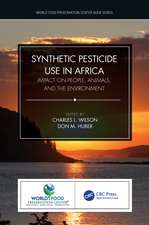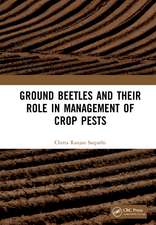Sensor-Based Quality Assessment Systems for Fruits and Vegetables: Postharvest Biology and Technology
Editat de Bambang Kuswandi, Mohammed Wasim Siddiquien Limba Engleză Hardback – 18 dec 2020
Key features of the volume:
• Provides an inclusive review of the developments of sensors for quality analysis and inspection of fresh fruits and vegetables
• Fosters an understanding of the basic sensing techniques for quality assessment of fresh fruits and vegetables
• Covers advanced sensing technologies, including computer vision, spectroscopy, X-rays, magnetic resonance, mechanical contact, wireless sensor networks, and radio-frequency identification sensors
• Reviews the significant progress in sensor development of noninvasive techniques for quality assessment of fruits and vegetables
Preț: 1010.89 lei
Preț vechi: 1232.79 lei
-18% Nou
Puncte Express: 1516
Preț estimativ în valută:
193.46€ • 198.12$ • 160.93£
193.46€ • 198.12$ • 160.93£
Carte tipărită la comandă
Livrare economică 18 martie-01 aprilie
Preluare comenzi: 021 569.72.76
Specificații
ISBN-13: 9781771889353
ISBN-10: 1771889357
Pagini: 324
Ilustrații: 43
Dimensiuni: 156 x 234 x 19 mm
Greutate: 0.77 kg
Ediția:1
Editura: Apple Academic Press Inc.
Colecția Apple Academic Press
Seria Postharvest Biology and Technology
ISBN-10: 1771889357
Pagini: 324
Ilustrații: 43
Dimensiuni: 156 x 234 x 19 mm
Greutate: 0.77 kg
Ediția:1
Editura: Apple Academic Press Inc.
Colecția Apple Academic Press
Seria Postharvest Biology and Technology
Cuprins
1. Real-Time Quality Assessment of Fruits and Vegetables: Sensing Approaches 2. Sensors for Ripeness Measurement of Fruits and Vegetables 3. Sensors for Sorting and Grading of Fruits and Vegetables 4. Fluorescence Tools for Sensing of Quality-Related Phytochemicals in Fruits and Vegetables 5. Electrochemical Sensors for Quality Determination of Fruits and Vegetables 6. Electronic Nose (E-Nose) Application in the Food Industry 7. IR Spectroscopy for Quality of Fruits and Vegetables 8. Nuclear Magnetic Resonance (NMR) Spectroscopy for Quality Determination of Fruits and Vegetable 9. X-Ray Imaging for Quality Detection in Fruits and Vegetables 10. Radio Frequency Identification (RFID) 11. Application of Computer Vision System in Fruit Quality Monitoring
Notă biografică
Bambang Kuswandi, PhD, is Head of the Chemo & Biosensors Group, Faculty of Pharmacy, University of Jember, Indonesia, and Visiting Professor at IChemTech, Faculty of Science & Technology & Fellow at IHRAM (Institute of Halal Research & Management), Universiti Sains Islam Malaysia. He was formerly Head of the School of Pharmacy and Dean of Faculty of Pharmacy at the University of Jember, Indonesia. Prof. Kuswandi was a Visiting Research Scientist and/or Visiting Professor at several institutes throughout the world, including Turkey, UK, Indonesia, Italy, the Netherlands, Malaysia, and the US. He has an H index of 18 and has been cited 1219 times (Google Scholar) for his over 60 papers published in refereed journals.
Mohammed Wasim Siddiqui, PhD, is an Assistant Professor and Scientist in the Department of Food Science and Post-Harvest Technology, Bihar Agricultural University, Sabour, India, and author or co-author of peer-reviewed research articles, book chapters, manuals, and conference papers. He has also edited and authored several books. Dr. Siddiqui established the international peerreviewed Journal of Postharvest Technology and is Editor-in-Chief of two book series (Postharvest Biology and Technology and Innovations in Horticultural Science), published by Apple Academic Press. Dr. Siddiqui has received several grants and respected awards for his research work by a number of organizations.
Descriere
Sensor-Based Quality Assessment Systems for Fruits and Vegetables provides an abundance of valuable information on different sensing techniques for fruits and vegetables. It covers emerging technologies, such as NMR, MRI, wireless sensor networks, and radio-frequency.






























